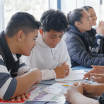Design assessments to enable students to demonstrate their understanding
Suggestion for implementing the strategy ‘Planning using UDL in intermediate and secondary settings’
On this page:
On this page:
Current page section: Design assessments to enable students to demonstrate their understanding
Go to top of current page: Design assessments to enable students to demonstrate their understanding
Go to top of current page: Design assessments to enable students to demonstrate their understanding
Go to top of current page: Design assessments to enable students to demonstrate their understanding
Align design to UDL
Align design to UDL
This video outlines potential barriers or challenges students may face that are unrelated to what is being assessed.
Support success
Support success
Discuss with students what support they need to demonstrate their understanding in assessments.
Consider:
- possible barriers hidden in the physical environment, for example, unfamiliar layout of room, lighting, temperature
- possible barriers hidden in the resources and materials, for example, cluttered presentation, hard-to read diagrams, unclear layout, hard-copy only
- approaches to managing time allocations, such as calendar tools and visual timers
- approaches to managing anxiety
- approaches to maintaining concentration
- negotiating breaks
- use of digital technologies such as text-to-speech and predictive text
- pre-teaching specific assessment/exam skills such as how to approach multiple choice questions
- identify whether SAC application needs to be made for NCEA.
Design assessments with students
Design assessments with students
Wayne Rangiruna describes the impact of student–teacher collaboration in assessment design.
Utilise the flexibility built into NCEA
Utilise the flexibility built into NCEA
NCEA is flexible.
Design assessments to suit the nature of the learning being assessed, as well as the varied characteristics and experiences of the students.
Avoid one-size-fits-all approaches as they will create unnecessary barriers for some students.
Consider:
- multiple forms of assessment, for example, demonstration, video, audio, poster, written, multiple choice
- active reflection – students spend time, individually and together, considering how they can demonstrate their learning
- what supports are needed to enable all students to have equal access, for example, screen reader, reader writer, more time
- student needs when giving feedback, for example, comments on Google Docs, face-to-face, videoing and analysing assessment tasks together – this could include: dance, drama, music, speeches.
- available exemplars with explanation and examples of what achieved, merit, and excellence looks like, for example, annotate NZQA assessments so they are meaningful for your students.
Source: Inclusive practice in secondary schools: Ideas for school leaders (opens in a new tab/window)
Reflection questions
Reflection questions
Consider the following questions in your own context.
- How do I evaluate the knowledge and skills that are directly related to learning goals and expectations?
- How do I ensure assessments are accessible, flexible, ongoing, and used to inform teaching and learning?
- Do I provide multiple means for students to express their thinking? How could I strenthen this?
- Can I co-construct more assessments with students whenever possible?
- Are all students offered the tools and approaches they need to be successful (text to speech, Reader and/or Writer, digital version, additional time)?
Source: Adapted from CAST UDL curriculum self-check (opens in a new tab/window)
Useful resources
Useful resources

Top 10 UDL tips for assessment
A assessment resource published by CAST, the Center of Assistive Technologies. It provides suggestions and questions on how can you use the UDL framework to design and reflect on assessments. This resource can be downloaded as a PDF.

Know students better: 15 tools for formative assessments
Read time: 21 min
A selection of digital formative assessment tools that can be used for free. Tony Gear has written about 15. Most of these tools work with any web browser, so they can be used on laptops, iPads, Chromebooks, tablets, and smartphones.
Publisher: Learning in Hand
Next steps
More suggestions for implementing the strategy “Design considerations in secondary settings”:
-
Current page Design assessments to enable students to demonstrate their understanding
Return to the guide “Universal Design for Learning”

How to use this site
Guide to Index of the guide: Universal Design for Learning
Understand:
- Why UDL is valuable
-
Find out about UDLShow suggestions for Find out about UDL
Strategies for action:
-
Design multiple means of EngagementShow suggestions for Design multiple means of Engagement
-
Design multiple means of RepresentationShow suggestions for Design multiple means of Representation
-
Design multiple means of Action and ExpressionShow suggestions for Design multiple means of Action and Expression
-
How to plan using UDLShow suggestions for How to plan using UDL
-
Design considerations in primary settingsShow suggestions for Design considerations in primary settings
-
Design considerations in secondary settingsShow suggestions for Design considerations in secondary settings
- Prepare environments for flexibility
- Refine and support goal setting
- Match teaching methods to student preferences
- Ensure materials are flexible and accessible
- Design assessments to enable students to demonstrate their understanding
-
Design considerations in NCEA assessmentsShow suggestions for Design considerations in NCEA assessments
